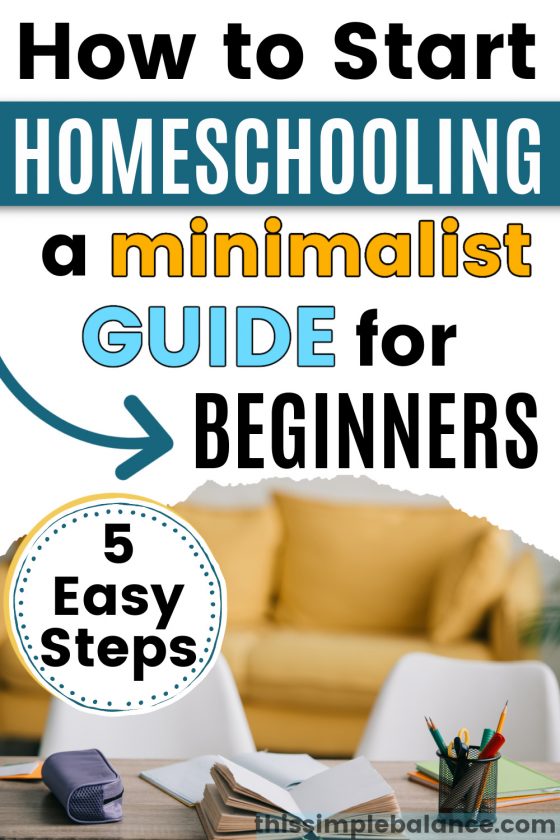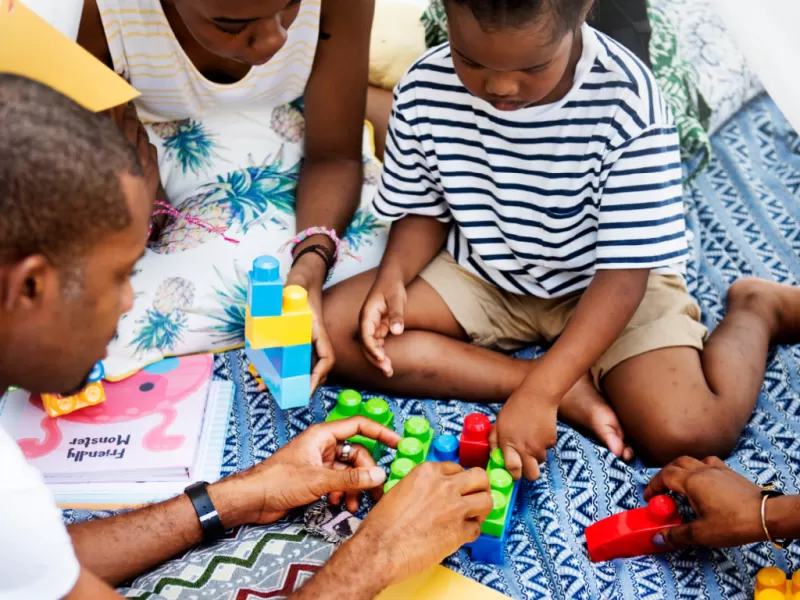Inside: You want to homeschool, but you have no idea where to begin? I’ve got you covered! Use this simple 5-step guide to start homeschooling with confidence. This is the guide I wish I’d had five years ago when I first started homeschooling.
How to start homeschooling. In theory, it’s not that difficult of a post to write.
But almost every homeschool parent I talk to has a story about how they started homeschooling, and every single one is different.
Their advice on how to start homeschooling might be slightly different from mine, which is why I encourage you to read multiple articles on the topic.
The fact that I’m even writing a post about how to start homeschooling is a miracle – that I even started at all, that is.
I almost didn’t homeschool.
Even though I desperately wanted to, I just didn’t believe in myself enough. I was SO scared to try and so VERY afraid I would mess it up big time.
Now? I see sending my kids to school as our worst-case scenario (no offense if you love school). I simply can’t imagine life any other way.
Hopefully that encourages you, that if you have even the slightest desire to homeschool, even if you’re totally scared you’ll screw it up, you CAN do this.
Disclaimer: I am not an expert in homeschool law. I speak from my own homeschool experience homeschooling in three different states. I strongly encourage you to read the homeschool law for your state or country as it is written for yourself to draw your own conclusions about what is required to start homeschooling.

Who Am I to Offer Advice on How to Start Homeschooling? My Homeschool “Credentials”
This post probably contains affiliate links, which means I may earn a commission if you make a purchase through those links. As an Amazon Associate, I earn from qualifying purchases. You can find our full disclosure HERE.
I have a M.Ed. in Guidance Counseling, which sounds good, but since I never technically used that degree, I’m not sure that counts as credentials.
What I DO have is ten years of hands-on, trial and error homeschool experience.
Personally I take homeschooling advice from people who have actual homeschool experience, and often who have been doing this the same amount of time or longer than I have.
When I started, I had four kids – one, a newborn – and I was extremely insecure.
The child of two teachers trained in traditional education and a product of traditional school myself, it took A LOT of deschooling for me to embrace relaxed homeschooling, and eventually unschooling (did you know that former teachers are turning to unschooling?).
It was a big leap to believe that my kids not only wanted to learn, but were naturally driven to do so. That they could be excited about learning without being coerced or bribed (a.k.a. grades and rewards).
From my first shaky steps using formal homeschool curriculum to striking off on my own relaxed homeschooling path, I’ve come a long way.
Today, our homeschool days are filled with:
- reading real books on our own,
- reading aloud to each other,
- deep discussions about anything and everything,
- gameschooling,
- playing outside in the woods and creek,
- field trips to science and history museums (pre-March 2020, of course),
- pursuing individual passions and interests, and
- last, but not least, living real life together.
Our homeschool doesn’t look like traditional school at all, and I hope that no matter where you land as far as homeschool styles go, you’ll quickly realize homeschooling shouldn’t look like school at all.
That being said, relaxed homeschooling and/or unschooling might not be the right fit for you. I certainly wasn’t ready for that when I first started homeschooling.
So, I’m going to do my very best to share with you all the general, essential, non-optional things that apply to every homeschooler, no matter your homeschool style.
I’ll also offer advice based on my own personal experience from homeschooling for five years with five children in tow (for better or for worse, I have lot of experience homeschooling with babies and toddlers under my belt).
This is the advice I wish I’d had when I started, all the things I wish I’d known when I was just starting out.
You Might Also Like: 24 Benefits of Homeschooling for Kids – to Remind You Why You Started

How to Start Homeschooling: A Simple Guide for Your First Year
Let’s jump into the five simple steps to getting started.
1. Know your homeschool laws, but don’t let them scare you.
Homeschooling in the United States can be ridiculously confusing. In one state, there is absolutely no regulation at all; in another, you are required to submit notarized paperwork every single year, PLUS meet with a teacher annually.
You need to know the laws for your state, and the easiest way I know to do that is to visit HSLDA’s website HERE.
Go ahead and look up your state. I’ll wait.
An Important Note About Withdrawing Your Child From School:
If your child is currently enrolled in school, make sure you follow the proper guidelines on your state’s Department of Education’s website for withdrawing your child from his current school.
This step is crucial to homeschooling success! If your child is still showing as “enrolled” and doesn’t show up at school, they will be considered truant, which can invite unwelcome scrutiny from the school district.
Not a fun way to start homeschooling.
If you happen to live in a state with little to no regulations, that’s awesome. Enjoy it!
You still should keep basic homeschool records (here’s what we do now that we’ve transitioned to unschooling), for your own peace of mind and just in case. That habit will come in handy when you’re homeschooling high school and tracking hours matters a lot more.
I recommend at least:
- a basic log of what you did every day and/or a book log with the books you’ve read
- a portfolio with work samples and/or photographs of fiekd trips and learning taking place
If you happen to live in a state that is highly regulated, like me, don’t let that scare you.
Know exactly what the law requires.
But especially if the regulations are written in hours of homeschooling required, remember that the things you do at home don’t need to look like “real school”.
So many different activities can count towards those hours. School doesn’t have to be all boring textbooks and a gazillion worksheets.
Also keep in mind that as any parent or teacher knows, school includes a LOT of busy work. Why? Because one teacher is trying to teach the same curriculum to a class of 25.
Take long division for example.
Even if a student masters long division in a single lesson, he will probably still be required to complete just as many worksheets as the student who can barely grasp the concept of 4 divided by 2.
That’s the nature of traditional school.
But if you’re homeschooling, you get to cut the busywork out.
When your child masters a subject, he doesn’t need to do hundreds of problems to prove he knows how to do them. He can demonstrate his mastery and move on.
Schools also count a LOT of things in their hours, things like:
- Recess & Lunch
- Transitioning from One subject to the next
- Bathroom Breaks
- Christmas Activities for 2.5 days before Christmas Break
- Field Day
- Substitute Teacher Days with, let’s be honest, busywork
- Pep Rallies
If you’ve been to school, you can probably think of a dozen more non-educational activities that schools count toward their required hours.
And if schools can count it, you can, too.
As you learn how to translate your homeschool activities into “school speak”, you will become much more confident that you are doing as much, if not more than, “real school”.
For example, reading aloud in our homeschool generally includes at least 3-4 of the following school subjects:
- Vocabulary
- Reading Comprehension
- Language Arts
- History
- Character Development
- Story Structure
- Civics
- Math
Once you learn how to communicate what you’ve done during a homeschool day into language schools can understand, you’ll most likely have no trouble proving that you’re meeting your hours/attendance requirements.

2. Determine how much time and money you have to invest in homeschooling.
The stay-at-home parent who doesn’t work has a lot more hands-on time to homeschool than the full-time working parent (and yes, working parents can homeschool).
The homeschooling parent with two older elementary aged children has a lot more time for projects and 1:1 work than the homeschooling parent juggling toddlers, babies AND elementary schoolers.
You need to start homeschooling with a realistic estimate of how much hands-on time you actually have. Otherwise, you’re setting yourself up for unrealistic expectations, disappointment, feelings of failure – all the negative things, basically.
Determine how much time you can give each day. Once you have that number, you can decide what actually requires your complete attention and involvement and what work can be done independently.
Now do the same exercise with money.
Sometimes the costs of homeschooling are difficult to assess because separating what you would normally spend on your kids (subscription boxes, books, art lessons, etc.) from what you spend just because you homeschool is tricky.
Especially if you are giving up a job to homeschool, your budget will probably be tighter than it used to be. Make sure you aren’t overspending on homeschool resources and track your spending over your first year to get an idea of what you actually spent.
You can definitely homeschool for free. Many homeschoolers use the library, free printables and unit studies, and free streaming options like educational Youtube channels or Kahn Academy.
Knowing your time and financial budget will help you make better curriculum choices for your first year.
Related: How Much Does Unschooling Costs? Typical Expenses & How to Save

3. Deschool yourself; deschool your kids.
Remember that the mindset shifts I mentioned earlier? In the homeschool world, making those mindset shifts about school is often called “deschooling”.
My friend and fellow homeschool blogger Kelly defines deschooling this way:
“Deschooling can be defined as removing the influence of the formal education system from your way of thinking. “
Kelly of Fearless Homeschool
While schools don’t say it outright, you leave school with the underlying belief that learning that happens at school is superior to learning that happens outside of it. And that learning can only look like…well, like school.
At school, learning is not self-directed at all. Students learn what teachers tell them to learn, the way teachers want them to learn it.
Have a different way to solve a math problem and still get the right answer? That’s nice, but you need to do it this way.
Want to start a sentence with a “but” or an “and” (which for the record, I do all the time in my writing)? Sorry, but proper grammar says you can’t do that.
Schools also use various forms of reward/punishment systems to motivate students to learn the required material.
Most kids learn at school because they have to and because they want the carrot that’s dangled in front of them, though the type of carrot varies from child to child (teacher’s approval versus staying in the same grade with their friends).
In school, natural, passionate, self-directed learning all but disappears.
When your kids come home from school for the day, are they eager to learn? Or do they groan at homework and required reading and anything that remotely resembles school?
There are exceptions, but the majority of kids breathe a sigh of relief when they get home from school. They associate learning WITH school, not with life.
It can take a while for their natural drive and curiosity to return. And it probably won’t return if homeschooling looks like school.
That’s what deschooling is for: giving them (and you) the time and space needed to look at learning differently, to recover their natural drive to learn, to return to what learning should be.
While you’re deschooling is a great time to think about your end goals for homeschooling!
What do you want your kids to know, to be like, to be able to do when you’re done homeschooling? Write it all down – it will guide your choices for years to come.

4. Find a homeschooler who is one step ahead of you.
Homeschooling is far from a mainstream choice.
Especially if you are facing opposition and criticism to your choice to homeschool, you need someone in your court, someone to ask questions when you have no idea what you’re doing, someone to talk you out of quitting homeschooling.
You don’t necessarily need a homeschool veteran, although that can sometimes be helpful to assure you that homeschooling can actually produce successful, well-adjusted, contributor-to-society adults.
I’ve personally found that the best support comes from someone who is a step or two ahead of you.
For them, everything is fresh. They remember what it felt like to start homeschooling.
To have days when you feel like a total failure. To have days when you are convinced you made a horrible choice to homeschool. To have days when you want to quit.
How can you find someone one step ahead of you?
- Facebook Groups
- Homeschool Blogs
This is one instance where social media is actually helpful.
Join a Facebook group for new homeschoolers.
Comment on Homeschool Instagram accounts that resonate with you or your homeschool style, and respond to other people’s comments.
Sign up for a homeschool blogger’s e-mail list, and don’t be afraid to e-mail with questions. It may take a bit for him/her to get back to you because they’re, well, homeschooling.
Don’t be shy!
One of my favorite homeschooler blogger turned friend I reached out to because her Pinterest account indicated she lived in my city. I messaged her, and we’ve been friends ever since.

5. Select a curriculum – here’s my advice.
You’ll quickly figure out that the ocean of homeschool curriculum is deeper than deep.
The choices are overwhelming, and unless you truly enjoy:
- sifting through a million curriculums
- reading through dozens of reviews
- weighing a gazillion of Facebook comments
Well, if you don’t love those things, you just might have a panic attack trying to make a decision. Or you’ll just need a very long nap all day for a week or two straight.
Then, when you’ve finally *think* you’ve made a decision, you’ll probably across that one scathing review that makes you question your decision all over again.
If you like that feeling, then by all means, carry on.
But if you hate that whole process, I recommend one of two paths: 1) starting with an all-in-one boxed curriculum OR 2) rejecting curriculum right from the start.
Thoughts on #1…
There is no way I would have been confident on my own as a new homeschooler everything put together and planned out for me. Somehow we scraped together the money to buy one (they can be pricier than DIYing your homeschool curriculum).
Boxed curriculums usually cover of all the state-required subjects. They lay it all out for you – the schedule, what to read and when to read it.
Boxed curriculum is kind of like training wheels for homeschooling.
I say that I couldn’t have homeschooled without it, and that’s with me ditching half of it within 3-4 months. That first year, I needed someone else calling the shots, someone else saying “do this”.
Gradually I found my wings, learned what I loved and didn’t love, and what worked for our family and what clearly didn’t (buh-bye Saxon math).
While we have moved away from “curriculum”, we did end up sticking with the overall homeschool style from that boxed curriculum (Sonlight/Bookshark) – learning through reading aloud.
It was well worth the money. I probably would have quit after that first year had I not had that curriculum guide holding my hand, especially because it resembled “real school”.
I needed something that looked and felt enough like traditional school at first. Especially because I first started homeschooling in Massachusetts – a state with stricter homeschool laws – I wanted all the boxes checked.
Eventually I learned that you can still check all the boxes without using strict homeschool curriculum. There are unschoolers/relaxed homeschoolers in every U.S. state, even the strictest ones!
But boxed curriculum was my first of many baby steps away from traditional school towards relaxed homeschooling and eventually unschooling, and I wouldn’t be where I am today without it.
Thoughts on Option #2
Or you could just jump straight into unschooling or relaxed homeschooling right from the get go!
If you can do this, I admire your confidence. If you’re already a natural rebel and ready to ditch schoolish mindsets right away, pick this option.
Follow your child’s interests, look for amazing resources to suggest, visit parks and museums, travel if you can. Live an amazing, connected life together.
But can I wholeheartedly recommend giving reading aloud a try? It’s not for every family or every child, but 4/5 of our kids love it (and the one that jumped ship didn’t do so until he was 9-years-old).
Related: 27 Best Picture Books to Read Aloud (Most Requested Re-Reads)
Did You Start Homeschooling Because You’re Ready for Something Completely Different From School?
Are you pretty confident doing things differently than your peers?
Do you know that you WANT homeschooling to look completely different from formal school?
If that’s you, and you’re homeschooling at the elementary level, I’d start your homeschool year with:
- reading aloud,
- playing educational board games,
- watching documentaries or educational shows,
- following your child’s passions, questions and interests.
Before you take this advice, please, please, please make sure you do Step One. Know your homeschool laws and what you need to do to stay legal.
If you are confident striking out on your own, and you’re homeschooling at the middle and high school levels, I recommend checking out these homeschool bloggers:
Give Yourself a Chance to Love Homeschooling
Homeschooling isn’t for everyone.
You might be someone who is genuinely a better parent when your kids attend school. Your kids might be happier in school.
It’s o.k. to not love homeschooling, to be the one sprinting to the school to sign your kids back up when they reopen or mid-year when you just can’t handle one more week with your kids home all day.
But I’d encourage you to give homeschooling a full year. One year to see if it’s for you long-term.
And I strongly encourage you to take that year to rethink education. To ask questions like:
- What makes a good education, anyway?
- What do kids truly need to be successful adults?
- What is the purpose of childhood?
Having clear answers to those questions will make decisions about education over the course of your child’s life SO much easier.
Welcome to homeschooling: I hope you LOVE it! We really can’t picture life any other way. ❤️
Read Next: 11 More Books Every Homeschool Parent Should Read


Excellent recommendations, June! I will be sharing all my newly homeschooling friends.
Thanks so much Heather!